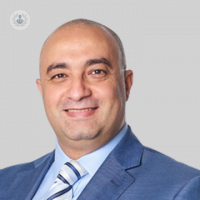What to expect from ankle joint replacement surgery and recovery
Escrito por:In this informative article, highly-respected consultant orthopaedic surgeon Mr Hisham Shalaby shares his expert insight on ankle joint replacement surgery, including what the procedure itself entails and what patients can expect from the recovery period to follow.

How is ankle joint replacement surgery performed?
Ankle joint replacement surgery is done under general anaesthetic and nerve blocks and usually requires a one night stay in the hospital. Nerve blocks are injections that are given around the big nerves of the leg to make the leg numb which helps with post-operative pain.
The operation involves a skin incision at the front of the ankle joint. To get the alignment right, we use an X-ray machine, and we perform certain steps, each ensuring a perfect alignment in a specific direction. This includes steps to get the rotation right, as well as the alignment in the front view, the side view and so on.
Once we are happy with the alignment, certain pins are placed in the bone. Over these pins, we position a cutting block which allows us to cut the bone in a specific way to ensure the ankle is in the best possible alignment. After that, any soft tissue balancing or release of tight structures is done. Finally, the soft tissues are closed in layers and the skin is closed with sutures. The leg is then placed either in plaster or a boot.
Is it painful?
The operation itself is done under nerve blocks, which have completely transformed the patient experience of this type of surgery. This is because they make the leg numb after the operation, far reducing the need for the strong analgesics after surgery. For most patients, the immediate post-operative period is okay and they don’t experience severe pain.
In the period following surgery, it is important that patients keep the leg elevated because this allows them to get on top of the swelling. Swelling is really the main cause of pain in the post-operative period, so managing this is key. The majority of patients may take pain killers for just the first few days after their operation but find their pain level is okay after this.
How long does it take to fully recover?
After the operation, the patient can usually walk straight away and put weight on their ankles. However, we do ask patients to stay off their feet for the first two weeks and to do very little as this helps to prevent excessive swelling and protect the wound. During this period, the patient can bear weight up to their tolerance.
At the two week mark, the stitches are removed and the patient carries on with the boot for another four weeks. During this period, the patient will undergo physiotherapy. There is a national protocol in Scotland that we have developed which involves certain steps, including core muscle strengthening, gait training, range of movement exercises, strengthening exercises to the tendons around the ankle and so on, which allow us to get very good outcomes from ankle replacements.
Six weeks after surgery, X-rays are performed and the boot is no longer needed. In the following few weeks, patients can start building up their walking. At this stage, they can also try some non-impact exercises like swimming and cycling. The swelling may come on and off for a good while but will ultimately fade away.
If the patient can work from home, they can usually get back to work within a week or less. If they have to commute, however, about six weeks is usually needed. In general, patients return to their daily activities on a gradual basis after that.
I tell my patients that making a full recovery and getting back to normal happens gradually and occurs when your brain forgets about the ankle. That tends to happen around the six month period in most cases.
If you require ankle joint replacement surgery and wish to schedule a consultation with Mr Shalaby, you can do so by visiting his Top Doctors profile.


